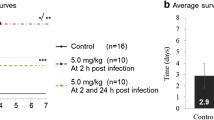Abstract
The T cell-derived macrophage-activating lymphokine, interferon-gamma (IFN-γ), is the most broadly acting antimicrobial-inducing and host defense-enhancing cytokine thus far identified in experimental models of infectious diseases. The activity induced by IFN-γ encompasses all classes of non-viral pathogens including intracellular and extracellular parasites, fungi and bacteria. In man, treatment with immuno-enhancing doses of IFN-γ is safe, well-tolerated and stimulates the antimicrobial mechanisms of blood monocytes, circulating neutrophils and tissue macrophages. Aerosol administration activates alveolar macrophages in a compartmentalized fashion. Monocytes from IFN-γ-treated patients with cancer, leprosy, and AIDS all respond with the activated phenotype, and suppressed monocyte HLA-DR expression in trauma patients can be upregulated by IFN-γ therapy.
Thus far, IFN-γ has been recognized as effective in the prophylaxis of chronic granulomatous disease and as adjunctive treatment in at least one systemic intracellular infection, visceral leishmaniasis. Additional trials suggest beneficial effects as prophylaxis in trauma and as treatment in leprosy, cutaneous leishmaniasis, and HIV- and non-HIV-related disseminated atypical mycobacterial infection. IFN-γ is also being tested as a prophylaxis in patients with burns and advanced HIV infection and as an adjunct in drug-resistant tuberculosis.
Future antimicrobial applications for IFN-γ include: a) long-term prophylaxis in T cell-deficient states, b) short-term prophylaxis in patients with a reversible host defense defect such as granulocytopenia or immune response suppression induced by trauma or burn injury, and c) adjunctive treatment along with conventional antibiotic therapy for i) nosocomial pneumonia (aerosol administration), ii) opportunistic infections in general, iii) infections which typically respond poorly to available treatment and iv) for infections which require prolonged therapy for cure. In the latter, the addition of IFN-γ may accelerate the response to conventional therapy and permit a clinically important reduction in the duration of treatment while preserving efficacy.
Similar content being viewed by others
References
Murray HW (1988) Gamma interferon, the activated macrophage, and host defense against microbial challenge. Ann Intern Med 108:595–608
Murray HW (1990) Gamma interferon, cytokine-induced macrophage activation, and antimicrobial host defense: in vitro, in animal models, and in humans. Diagn Microbiol Infect Dis 13:411–421
Murray HW (1994) Interferon-γ and host antimicrobial defense. Am J Med 97:459–467
Gallin JI, Farber JM, Holland SM, Nutman TB (1995) Interferon-γ in the management of infectious diseases. Ann Intern Med 123:216–224
Murray HW, Berman JD, Wright SD (1988) Immunochemotherapy for intracellular Leishmania donovani infection: interferon-γ plus pentavalent antimony. J Infect Dis 157:973–979
Jaffe HA, Buhl R, Mastrangeli A, Holroyd KJ, Saltini C, Czerski D, Jaffe HS, Kramer S, Sherwin S, Crystal RG (1991) Organ-specific cytokine therapy. Local activation of mononuclear phagocytes by delivery of an aerosol of recombinant interferon-γ to the human lung. J Clin Invest 88:297–302
The International Chronic Granulomatous Disease Cooperative Study Group (1991) A controlled trial of interferon gamma to prevent infection in chronic granulomatous disease. N Engl J Med 324:509–516
Polk HC, Cheadle WG, Livingston DH, Rodriguez JL, Starko KM, Jaffe HS, Sonnenfeld G (1992) A randomized prospective clinical trial to determine the efficacy of interferon-γ in severely injured patients. Am J Surg 163:191–196
Dries DJ, Polk HC (1994) Interferon gamma in trauma-related sepsis: results of two large multicenter studies. (Abstract) 6th International Congress for Infectious Diseases, April 26–30
Murray HW (1990) Interferon-γ therapy in AIDS for mononuclear phagocyte activation. Biotherapy 2:149–158
Harms G, Chehade AK, Racz P (1989) Effects of intradermal gamma interferon in cutaneous leishmaniasis. Lancet 1:1287–1292
Sundar S, Murray (1995) Effect of interferon-γ alone in visceral leishmaniasis. J Infect Dis 172:1627–1630
Nathan CF, Kaplan G, Lewis WR (1986) Local and systemic effects of intradermal recombinant interferon-γ in patients with lepromatous leprosy. N Engl J Med 315:6–15
Arana BA, Navin TR, Arana FE (1994) Efficacy of a short course (10 days) of high dose meglumine antimonate with or without interferon-γ in treating cutaneous leishmaniasis in Guatemala. Clin Infect Dis 18:381–384
Bardaro R, Johnson W (1993) The role of interferon-γ in the treatment of visceral and diffuse cutaneous leishmaniasis. J Infect Dis 167 (Suppl 1):13–17
Falcoff E, Taranto NJ, Remondegui CE (1994) Clinical healing of antimony-resistant cutaneous and mucocutaneous leishmaniasis following the combined administration of interferon-γ and pentavalent antimonial compounds. Trans R Soc Trop Med Hyg 88:95–97
Sundar S, Rosenkaimer F, Murray HW (1994) Successful treatment of refractory visceral leishmaniasis in India using antimony plus interferon-γ. J Infect Dis 170:650–662
Sundar S, Rosenkaimer F, Lesser ML, Murray HW (1995) Immunochemotherapy for a systemic intracellular infection: accelerated response using interferon-γ in visceral leishmaniasis. J Infect Dis 171: 992–995
Squires K, Brown ST, Armstrong D, Murray HW (1992) Interferon-γ treatment forMycobacterium avium-intracellulare bacillemia in patients with AIDS. J Infect Dis 166:686–687
Sattler F, Walser J, Golden J (1993) Recombinant gamma interferon aerosol for treatment of Pneumocystis pneumonia. (Abstract) IXth International Conference on AIDS, Berlin, June 6–11
Steinmann G, Rosenkaimer F, Leitz G (1993) Clinical experience with interferon-α and interferon-γ. Int Rev Exp Pathol 34B:193–207
Author information
Authors and Affiliations
Rights and permissions
About this article
Cite this article
Murray, H.W. Current and future clinical applications of interferon-gamma in host antimicrobial defense. Intensive Care Med 22 (Suppl 4), S456–S461 (1996). https://doi.org/10.1007/BF01743724
Received:
Accepted:
Issue Date:
DOI: https://doi.org/10.1007/BF01743724




